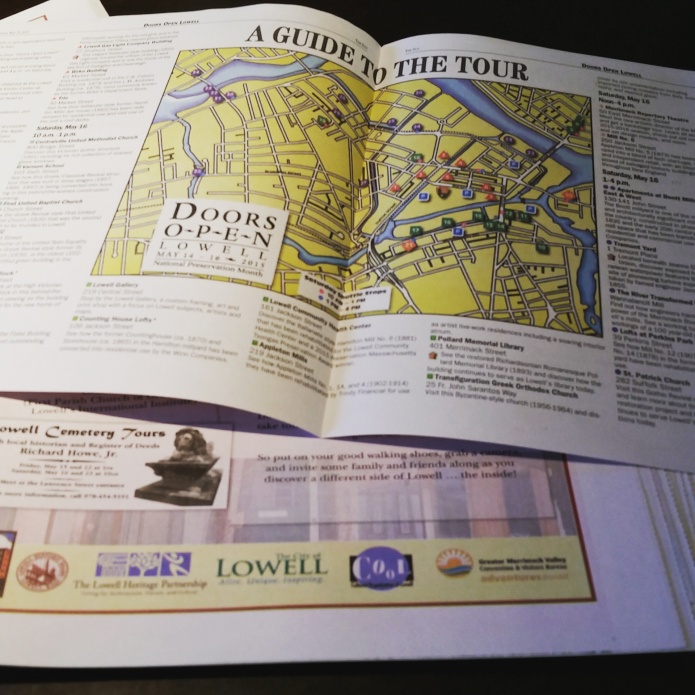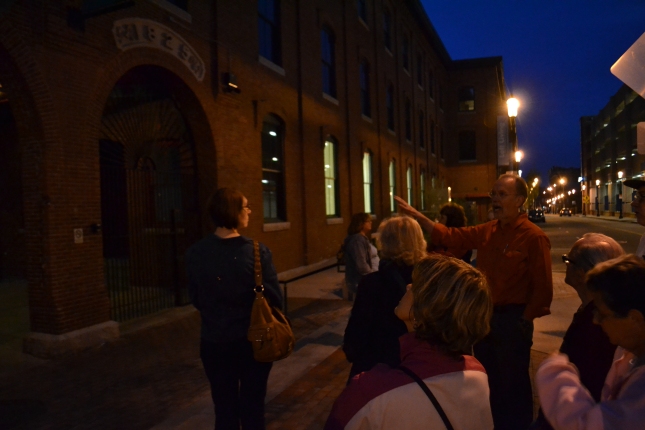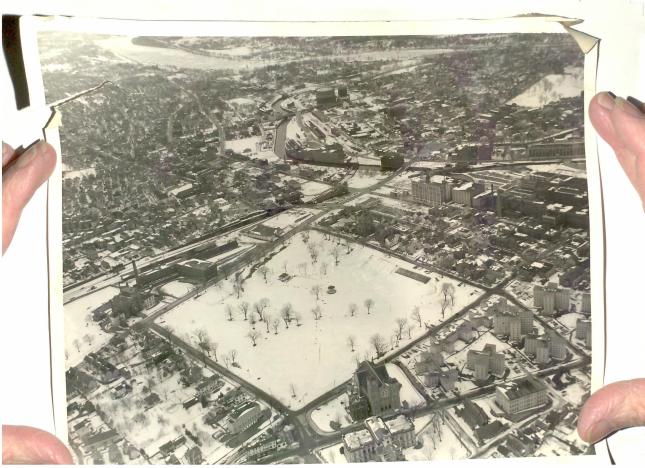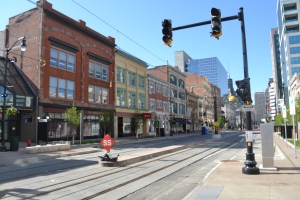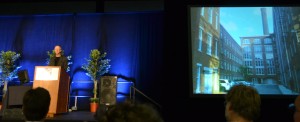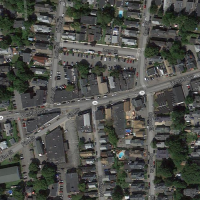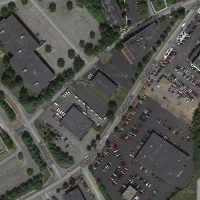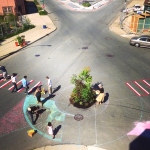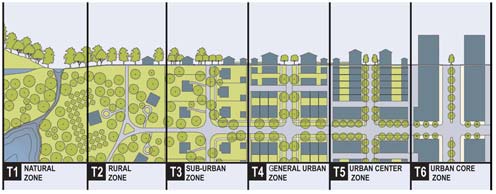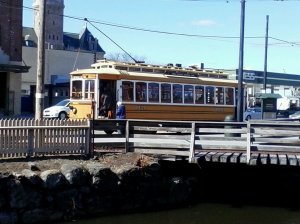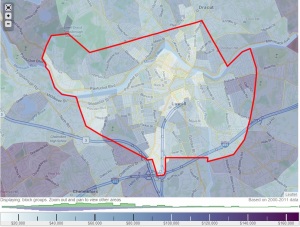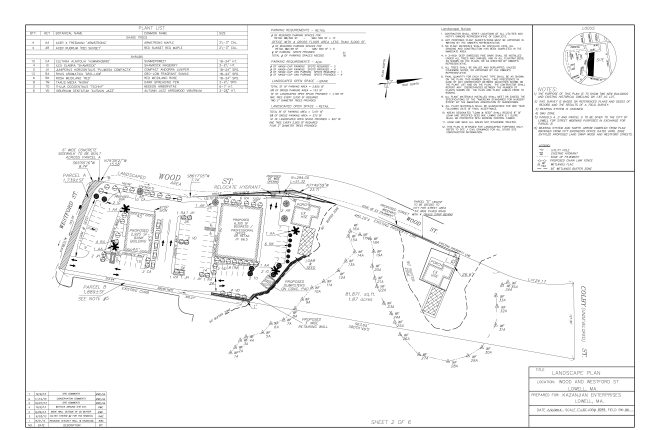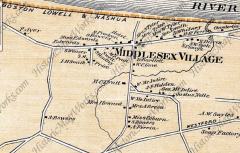A couple of weeks ago, we reviewed the panelists of “Lowell Looks Ahead,” a talk show roundtable hosted by Teddy Panos of WCAP, and what the panel said about education’s role in economic development.[1] This week, we will cover the remaining themes. Notably, this post won’t cover the show verbatim, as panelists skipped back and forth between topics. Rather, panelists’ comments are arranged by topic with my own thoughts and fact-checking interspersed. I encourage anyone interested to listen to the remarks made in context here.
One important topic that won’t be covered is the Lowell High School. We’re planning a series of posts about this topic, and we will include the panel’s comments there.
Downtown Developments
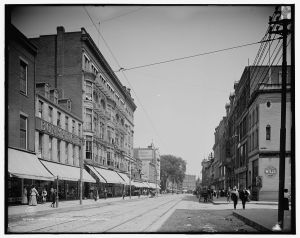
Bon Marche as it once was. (Courtesy of Library of Congress/Forgotten New England)
Perhaps the most controversial items the panel discussed were about Lowell’s downtown. Most of the panelists lived in Lowell when major department stores such as Bon Marche and Cherry & Webb were downtown. The panel agreed that the retail anchor model was unlikely to return. George Behrakis recalled a turning point when he was speaking to a friend as Chairman of the Chamber of Commerce:
He said to me, “Listen, shopping centers have taken over. If local communities are to be competitive, you need parking where your store is. The women are not going to walk from a parking lot to the store. The old days are gone where everybody walked downtown or took the bus downtown.” –George Behrakis
Jim Cook, of Lowell Plan, spoke during one segment of the show and agreed that a large department store “is not going to happen.” However, he noted that smaller start-ups funded by the Lowell Development Financial Corporation, such as the Back Page, are finding success and stability.
Chancellor Marty Meehan of UMass Lowell mentioned another important development:
We have a proposal from a potential developer that would build a hotel and also looking to build private housing as well. They’re in negotiations right now, talking to that developer, but nothing has materialized yet. –Chancellor Marty Meehan
Chancellor Meehan also noted that environmental cleanup needs may impede development. There haven’t been any announcements about the parcel since the show. The Chancellor also noted that, although state funding was not available to build an adjacent practice rink at the time of Tsongas Center’s construction, “Frankly, going division 1 in all sports… is going to mean that we need to get that practice rink that should have been built, really, in the beginning.”

Comfort Furniture Building (Courtesy richardhowe.com)
The show also included Sal Lupoli, who recently purchased the former Comfort Furniture building, a prime development site near Gallagher terminal. Mr. Lupoli explained that he negotiated for “well over” three years with the two owners, before finally reaching a deal. He now plans market-rate housing atop destination retail such as “a restaurant, a small upscale pub or small upscale environment whether they’re getting off train or bus.” He credited the state delegation for including funding in the Transportation Bond Bill for an overhead connection to the Gallagher terminal parking garage.
Regardless of anything else, I believe Mr. Lupoli’s successful negotiation is impressive. Jerry Caplan is the owner of Thorndike Mill Outlet and former co-owner of the building.
What we need to do is work with Jerry, because he’s local, and what we believe in as a company… is to “enhance, not disrupt.” –Sal Lupoli
Mr. Lupoli said that there was a “small timeframe” for Mr. Caplan to downsize, but he hopes to keep Mr. Caplan there “for a while.” He also says that development will move slowly, so that he can work closely with the City Council and planners to “maximize” the site.
Despite positive developments, the panel believes downtown vacancies are a problem. Mr. Panos said bluntly, “Our main drag is pretty barren.” Mr. Cook agreed vacancies are a concern, but argued that downtown’s vacancy rate was comparable to nearby malls’ vacancy rates, suggesting much of the turnover was related to personal reasons or larger trends and not downtown’s viability.
Mr. Cook may not be far off: the 2012 overall retail vacancy rate was 7.9% in Boston’s northwest suburbs (including Greater Lowell), and Lowell’s downtown retail vacancy was 8.55% last December, but up-to-date reports are costly. Regardless, it is clear that the vacant, prominent storefronts trouble many in the city.
Are Lowell’s Demographics Problematic?
Many blame downtown’s difficulties on its surrounding demographics. Mr. Panos suggested that because of downtown’s large number of income-restricted housing units, there are not enough residents with “disposable income” to attract chain retail, restaurants, and boutique stores. The panel agreed. Mark O’Neil brought up a chicken-and-egg problem: amenities that would attract upper-income residents will not move in without upper-income residents. He said, “Trader Joe’s is not going to come downtown. A hardware store would not survive.”
Mr. Behrakis turns to “Griffin Report” and “Advertising Age” for real estate trends, and says:
You look at “what is the spending power of Lowell in downtown.” Because there isn’t any there, no one’s coming. –George Behrakis
I know of a saying in real estate: “Retail follows rooftops” (the commercial market lags the residential by up to a year.) Initial residential attraction could be related to a combination of affordability and interesting destinations. When enough of these residents move in, chains crunch the numbers and move in, in turn attracting more residents in a virtuous cycle.[2] However, each resident supports only a limited amount of retail, regardless of their income. A “rule of thumb” is that each household can support 15 to 20 square feet of walkable retail, and I plan to do an analysis based on this rule in a future post.
Mr. McCallum suggested an additional problem: as properties are turned into residences; those properties are taxed at the lower rate even though residents require more services. Research consistently shows that residences generally cost a city more than the taxes they generate, regardless of whether a split rate is used. This is a problem for every town.
Can Downtown Attract Out-of-Towners?
If converting storefronts to residences to “correct” the size of downtown is off the table, downtown must attract shoppers from out-of-town. Speaking on this, Mr. McCallum said, “If you build it, they will come.” He listed attractions and events that already attract residents, but Mr. O’Neil countered that he lives in Westford, and although his friends go to Lowell to attend a ballgame or restaurant, they “go right home” afterward.
This echoed a sentiment Mr. Behrakis made early in the program:
…you’ve got to change your philosophy, you’ve got to change your style of downtown. Whether it’s the Market Street or John Street garage, they’re not going to walk at night to go to a restaurant. It’s very difficult [even] for [Memorial] Auditorium, to park in the parking lot, for a woman to walk across the street. You have to go down at ten or eleven at night, and tell me if you’re going to walk alone. So, safety is a big factor for the downtown. Women going to a restaurant at night, they don’t want to go near a bar, walking home going to their car.
Although I think there are absolutely will walk if there are good destinations and proper amenities such as lights and good sidewalks, I did agree with Mr. Behrakis on another point: he advocated for more effort to attract businesses (and therefore lunch and after-work customers) to upper stories of downtown buildings. He said, “They will spend money. Housing won’t bring in money.”
Business Friendliness and Taxes
Following this, the question may be whether Lowell is a competitive location for businesses. When asked this, the panel immediately brought up Lowell’s tax rates. Robert Caruso, CEO of Lowell Five Bank, said that Lowell Five’s property taxes rose 66% in five years and “That is not an indication it is a business-friendly environment.” He said Lowell had one of the highest commercial rates in Massachusetts, sending a “bad message.” He said Haverhill had a more competitive rate.
Mr. McCallum and Mr. Behrakis agreed. They said that businesses look at the total cost of running that business, and taxes are naturally part of the cost. While Mr. McCallum compared Lowell’s taxes unfavorably to other parts of the United States such as North Carolina, Mr. Behrakis said that he owns properties in Lexington, Bedford, Haverhill, Cambridge, and Boston, and that Lowell ranks #1 in taxes. He says an “old community” like Lowell cannot compete on taxes.
Mr. Panos mentioned that most city officials he’s spoken with have said that businesses “don’t look” at the tax rate, but suspects the real reason the tax rate is not changed is because it is “political suicide” to suggest a residential tax increase. He argued that it is “shortsighted thinking,” but nobody is “getting through to the elected officials,” and they show a lack of understanding of what motivates businesspeople to open businesses.
I actually have to partially disagree with the panel. Studies show that although business owners often cite taxes as a primary concern in surveys, links between tax incentives and job growth are ambiguous at best. Business’s behavior shows that infrastructure, cost and skill of local labor, local supply and demand, and even ease of navigating land use regulations are more important in their decision-making. Retailers will look for customers, tech companies will look for places that skilled workers want to move, and manufacturers will look for a combination of good transportation infrastructure and low labor costs.
I do believe Mr. McCallum is correct in that taxes are a consideration. However, the relative importance of taxes is different for each business type; rate is less important than overall tax bill; and tax stability is nearly as important. A developer wants confidence that when she creates a pro-forma for a property, her predictions on income and cost will both be close to correct. The taxes will then be factored into how much the developer will offer for the property. However, if there’s a worry that there will be a sudden jump in taxes, it’s much harder to determine an offer. This is not to underestimate how important efficient use of taxes is. A successful community cannot have a high tax without infrastructure, amenities, and services commensurate with that tax.
This is why Marc O’Neil’s observation requires some consideration. He predicts that there will be a tax increase in this fiscal year and believes that the rate should be more balanced between residences and businesses. He suggested that the business community needs to come together as a force to ask for lower business property taxes, and that it stops “people from coming in or expanding.” I would be very interested to know which businesses may have considered Lowell if it weren’t for taxes.
Is it Just an Attitude?
During Sal Lupoli’s segment, Mr. Panos asked, “Why did you choose Lawrence first?” Mr. Lupoli explained that he originally wanted to open a store on Merrimack, but it didn’t work out and he opened instead in Salem, New Hampshire (in 1990). In 2002, he sought to expand from his Salem facility into Massachusetts and examined Lowell, Lawrence, and Haverhill because of their large, talented labor pools. As to how he made a final choice, he said, “To tell you the truth, it was the City of Lawrence that refused to let me leave the office.”
He expanded:
Any entrepreneur, woman or man, that creates their business from scratch, they want to be welcome. Because as an entrepreneur, you have a lot of things you’re dealing with on a daily basis, and when it comes to the permitting process, or when it comes to building that public-private partnership, you want to be welcome… You want resources only the town offers or has has access to or has tacit knowledge of in order to be successful.
He said that the ideal city makes an entrepreneur say, “How can I fail,” because of people “rooting for” the company and offering resources. He said that it was the “little things that make all the difference, because that may be the tipping point.”
I will tell you today, and it’s because of 25 years of hard work, I go into communities that want me in that community. If I knock on somebody’s door and the Town Manager or the Mayor answers the door in some respect, and it’s lukewarm, or they start to tell me about all the hurdles, and they say “no because,” instead of “yes yes,” Then you know what I do? I politely shake their hands, wish them well, and I go on to the next community that wants to take my tax money, or take the opportunity to create some kind of business in that community. And there are plenty of communities in these 350 plus towns and cities that want jobs and want tax revenue.
In my experience, Mr. Lupoli’s position is common. It’s a fact that communities compete with one another. In many cases, this inspires communities to be efficient, creative, cooperative, and uncorrupt. Other times, it becomes a mere competition between states that to give the largest tax break. Regardless, Mr. Lupoli mentioned that the City of Lowell’s reception had been “nothing but positive,” mentioning that Lowell’s three representatives “have always embraced” him.
Partnerships
This speaks to an important theme revisited throughout the panel: partnerships between business and public entities. Teddy Panos asked the panel whether City Councilors approached each of them for advice. Mark O’Neil laughed that the “City Manager constantly comes to us.” Quite a few candidates reached to Mr. McCallum, and mentioned that it was a two-way street. Businesspeople also have the power to reach out to officials, and he always had a good relationship with them. He never had issues and would meet “not frequently, but once in a while.”
Mr. Caruso said he talked to only Corey Belanger, Rodney Elliot, John Leahy, and Rita Mercier in the previous election, and was asked about the location of Lowell High School and economic development. He credited them for making time, as Lowell has many competing issues, and it is sensible that a single business manager would not be a priority. Nevertheless, he believes there is not enough political outreach. He noted public/private partnership in Lowell has been a winning strategy for many years, and that the state delegation has continued to be cooperative with business.
I did find it notable that the three of the four City Councilors Mr. Caruso named have made many of the economic development-related motions in 2014, such as creating a downtown hotel initiative, downtown task force, or weighing in on the Lowell High School decision.
The Lowell Plan: Is its Next Step a Shared Marketing Campaign?
 Mr. Caruso previously sat on the board of the Lowell Plan, and said that this was one vehicle that “at least used” to serve as a vehicle for public/private cooperation. Mr. Cook, its director, said that losing someone with “the stature of Paul Tsongas” changed the Lowell Plan’s role. He said that it now operates behind the scenes and provides a “sort of round-table” where business community and elected officials can talk about the community.
Mr. Caruso previously sat on the board of the Lowell Plan, and said that this was one vehicle that “at least used” to serve as a vehicle for public/private cooperation. Mr. Cook, its director, said that losing someone with “the stature of Paul Tsongas” changed the Lowell Plan’s role. He said that it now operates behind the scenes and provides a “sort of round-table” where business community and elected officials can talk about the community.
Many initiatives have come out of this dialogue, such the American City Corporation 80s downtown study, partnerships with UMass Lowell and Middlesex Community College, the “There’s a Lot to Like About Lowell” marketing program, the 10-year plan for downtown, and more recently, the “Downtown Evolution” plan by Jeff Speck Associates. Mr. Cook agreed that the city needs to begin a “solid marketing program” for 2014, and believes Lowell Plan can push that initiative forward.
I’ve recently learned that the Lowell Plan is being used as a model for both Lawrence and Salem. Not only does it facilitate dialogue, it plays unsung roles as well: as a private agency, it can start programs and make deals without the red tape of the federal or state governments. It can also hold private meetings, where businesspeople and city officials can be frank without worrying about political repercussions. However, this “lack of transparency” is often what many citizens critique. To me, this is a difficult balance to achieve. Backroom deals invite corruption, but too much control makes it difficult for the government to move quickly, think beyond the election cycle, or take perhaps-proven actions that nevertheless don’t fit within cookie-cutter enabling laws.
Chamber of Commerce: Focusing on the Positive
 Danielle McFadden, President and CEO of the Greater Lowell Chamber of Commerce, spoke on their role in economic development:
Danielle McFadden, President and CEO of the Greater Lowell Chamber of Commerce, spoke on their role in economic development:
The partnerships that are happening right now are really great. We can all continue to work together. We can keep the conversations going. –Danielle McFadden
Although Ms. McFadden acknowledged the problem of vacant storefronts, she focused on the positive. She shared that Little Delights is working on coordinating businesses for a shared mailing. The owners of El Potro said that their reception in Lowell was better than Somerville, and they were amazed that they were invited to a City Council meeting and that the mayor attended their opening.
When asked whether the Chamber of Commerce received pushback from businesses in the outer neighborhoods and the outer suburbs because of the amount of focus on Lowell’s downtown, Ms. McFadden reported there was no pushback. She believed that they agreed that “Naturally you will gravitate toward downtown. A vibrant downtown creates a destination.”
Why Should We Have a New Partnership?
One of the suggestions that came out of the panel was for a new committee that might assist businesses and the City working together.
Good government creates good communities. We have a good government. We have a city council, a plan E. I think they should put together, as I mentioned before, I think the Mayor needs to put together a committee to look into all this and work with the Lowell Plan, the Chamber of Commerce, but also the business community. –George Behrakis
He suggested strategizing and “bringing in consultants.” We mentioned this idea in “Quite a Task: Downtown Lowell Task Forces,” but since then, I’ve heard Mayor Elliot has been working on forming the committee. I hope he releases more information soon, as I was unable to tell from the panel why they felt existing venues did not serve their needs.
Partnerships between Businesses and Residents: Do they Understand One Another?
Toward the end of the show, Mr. Panos mentioned that many asked him to include a resident perspective, but he mentioned that WCAP features citizen perspectives “every day.” However, the producers looked to businesspeople for the panel because, “If you’re looking to create medicine, you go to a pharmacist or doctor… if you’re looking to create jobs… you’re going to go to the folks who employ people.”
He thought that residents did not understand the business perspective, such as in the debate between residential and commercial tax rates or even in the national attitude about income inequality. He asked the panel how to bridge that divide. Mr. McCallum suggested:
Put them to work in good-paying jobs. That’s what we need to do. People will understand that. They can relate to it, obviously. You’ve got to take this from conversation to reality. And the reality is that people need a livelihood. –Elkin McCallum
Mr. McCallum believed that regardless of anything else, the economy changed and people just want to return to well-paying jobs. He praised philanthropists for bridging the divide, and believed there was mutual respect, but not understanding. However, Mr. Caruso suggested it was because of national tone:
I believe part of our divide today is because of our politicians… They’re talking about income injustice and inequality, that’s going to be a big thing you will hear about… What we need is unity, and we have to stop the name calling. –Robert Caruso
He believed Senator Elizabeth Warren, criticizing big business, is causing part of the divide. Mr. Behrakis agreed that partisan politics is creating disunity, compared to his experience decades ago.
What Path Lowell?
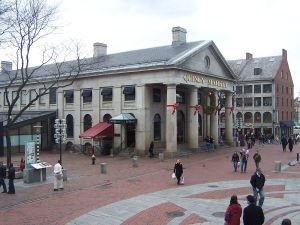
Rouse’s first and most famous festival marketplace (Courtesy wikimedia)
Ultimately, the key question for Lowell’s downtown is how to attract shoppers and businesses. Mr. Behrakis believes the city should have followed a 1970s-era plan:
When Paul Tsongas was in town, he brought the group together, people that did Fanuiel Hall and Copley Place [American City Corporation, a subsidiary of Rouse Company]… I still have the plans, because I was on that committee. I don’t think too much was done to revitalize. –George Behrakis
Rouse Company was famous for designing and promoting shopping centers in the 1950s, planned communities in the 1960s, and festival marketplace conversions such as Fanueil Hall in the 1970s. James Rouse also advocated for large-scale urban renewal projects. I have never seen their Lowell plan, but from the description, it included changes to make downtown more of a destination shopping area than a traditional downtown.
Several other plans (detailed briefly here) have been drafted subsequently. Speaking about these, Mr. Panos said:
Every couple of years, we do one of these “how to fix the downtown things” but we haven’t been able to really settle on one thing. Is the Jeff Speck plan the way to go, or is the city and the downtown still seeking for an identity? –Teddy Panos
At another point in the show, Mr. Caruso said to Mr. Panos, “You and I, we laugh a lot. The only thing that came out of Jeff Speck so far is the bicycle lanes.” He also said:
Some of the ideas that the people who… have a history here in Lowell, I think add more [than] having somebody come in from the outside and tell you “this is what you really need.” –Robert Caruso
The panel agreed that plans are made without resident input or thought to previous plans. However, to me, each effort has built upon the last, incorporating local input, goals, and ideas. Incomplete action items from older plans are often included, as they can only be executed when conditions are right—for example, a trolley expansion or a development next to Tsongas Center. However, given that an agency rarely wants to advertise “what it has left to do,” perhaps implementation could be more systematically tracked and advertised.
A Highway Downtown?
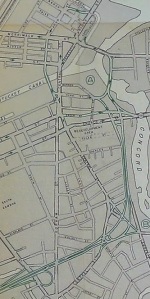
Lowell Connector to downtown, as proposed in 1956 (coreysciuto.blogspot.com)
The panel did suggest some ideas, and Mr. Behrakis suggested a controversial one:
I know I’m going to bring up a controversy, but I think the bigger mistake Lowell made, many many years ago, and I was a young man, I was proponent, but I got shot down. The [Lowell] Connector should have been going all the way into downtown Lowell, and not stopped at Gorham street, which is a disaster area. That Connector could have been the vitalization of downtown Lowell.
But you know with politics, with people saying “the community, you know, the neighborhood’s going to be…” Hey, listen! You’ve got to make the moves. You don’t make the moves, you gotta be positive.” The Connector is like a dead-end street, and you’ve got people coming into Lowell and saying, “Where do I go now?”
Mr. Behrakis reasoned that people have trouble finding the Tsongas Center, and Mr. Panos mentioned Thorndike Street must serve in that capacity. This position was common fifty years ago, as property owners believed poor access and congestion was causing downtowns to fail, and opening downtowns up would lead to lucrative redevelopment projects.
Unfortunately, urban cores never can have the ease of access of a suburban office park or shopping center. Highways ultimately destroyed the urban core amenities that are now attracting young people back into those cores. As a 2012 report describes, communities are actually finding success in removing, not expanding, their highways, such as Portland, Milwaukee, Toronto, and most famously, San Francisco.
Looking to Other Cities
However, the group suggested other solutions that are smaller-scale in scope. Bob Caruso mentioned that Newburyport was a “ghost town” in the 1950s and 1960s, and recommended studying cities such as that and Portsmouth, NH, and replicating their methods. Both cities used a historic preservation approach to their downtowns.
Mr. Behrakis cited Quincy’s redevelopment project as a model of success. Mr. Behrakis mentioned it was a $500 million project, but in actuality, the public-private project now totals $1.6 billion and has recently hit troubled waters as redevelopment did not move forward after demolition. The project reportedly has left part of its downtown empty for five years.
Although laws put in place during the funding of Lowell National Historical Park restricts demolition in Lowell’s downtown, the panel took a surprisingly cavalier tone toward historic preservation. Not only did Mr. Panos make jokes about the efforts put into preserving the Bowers House, Mr. Behrakis also spoke disapprovingly about Lowell’s preservation focus:
You aren’t going to tell me a building from 1920 is a historical building. A historical building is Europe 1,000 years ago, 250 years ago. –George Behrakis
In addition to Quincy, Mr. Behrakis cited the convenience of Nashua, New Hampshire’s, behind-business parking. Mr. McCallum also praised Nashua. Although Nashua does has an attractive and successful downtown, Nashua’s own planners suggest this is due to “grassroots organizing and one small intervention after another” to undo damages of large-scale, postwar urban renewal projects. Their downtown plan states that although Main Street is thriving, it is cut off from the rest of downtown.
Smaller Scale Solutions
Small efforts may be more feasible for many reasons. Mr. Caruso suggested replicating the valet parking featured in Boston’s North End. Visitors may pull up to restaurant front doors, and valets park their car in a safe location elsewhere. Mr. Caruso suggested that the valets work mostly for tips, and that Lowell Five parking lots may be used for secure after-hours parking.
Mr. Cook suggested that some businesses should consider stronger marketing toward the new market-rate apartments and condominiums downtown, extending their hours to be convenient to these residents. Some on the panel took exception to this, believing that business owners closed at 5:00 pm because they saw no business after that. In actuality, I’ve seen that some restaurants, such as Centro, are actually reducing lunch hours.
Does Lowell need a Visionary Leader?
Although it was not the last topic discussed, it may be a good topic to end on: How could Lowell move these ideas forward? The panel had diverging opinions. Mr. Panos suggesting that nobody since Paul Tsongas had the “gravitas” to “pull everyone together.” Later during the same section of the show, he said Sustainable Lowell 2025 was “Kind of a state of the union address but didn’t have a lot of specifics.”
Mr. Behrakis believed Chancellor Meehan or others were capable and could advance economic development projects including beautification, demolition, and expanding parking.
Mr. O’Neil believes the media could—and should—play an advocacy role in the Lowell High School decision:
I think the media can help play a role of advancing things, and hopefully presenting all options, both sides. But, taking a stance, and the Sun—love it or hate it—has always been one of those institutions that took a stand and played a key role and help make things happen in concert with the business community and the residents. –Mark O’Neil
Although he said he wasn’t sure about a single individual, but rather many leaders from government, the school committee, business community, and residents should cooperate. He said the newspaper “would be happy to take a lead role in helping to advance it.”
This is something I have thought about a great deal, both in Lowell and elsewhere. I’ve read solid arguments that cities succeed partly because of strong leaders, and big, somewhat risky ideas sometimes pay off in great ways. However, it seems that the cities that have best recovered from deindustrialization do hundreds of tiny things right every day. They capitalize on their unique resources and history; market these resources successfully to businesses; and create strong links both between businesses and between public and private sectors. For example, Pittsburgh found success by consistently and fairly capitalizing on development to enhance transportation and recreation while maintaining key partnerships with universities. This was sustained over the terms of multiple mayors.
This is why I remain skeptical of “mega-projects.” Although Richard Florida, famous for terming “creative class,” is somewhat controversial, he has researched hundreds of cities, finding that mega-projects have not helped cities recover: “As with so many things in life, the small stuff really can make a difference to the people living in cities.” Researcher George Harbor statistically analyzed cities that formerly relied on manufacturing, and found workforce development, low cost of business, and network facilitation may be key policies. These policies don’t need a single, visionary leader, but rather an army of qualified individuals each doing their part.
There’s a Lot to Like about Lowell
In any case, the panelists were optimistic about Lowell’s future.
There’s a new discussion, here in Lowell, I think that’s the most important part of it. –Bob Caruso
Mr. O’Neil agreed that the business community was optimistic. Mr. McCallum agreed, recalling the Lowell High School hall of fame that included Mr. Behrakis and himself, Donna McCallum, Paul Tsongas, and Jack Kerouac. He cited everything from e-commerce to big box retail.
There’s a lot to like about Lowell. What I have always been a part of and felt good about was its spirit. –Elkin McCallum
I respect how strongly these businesspeople feel about Lowell and agree that there is a positive spirit in Lowell. As always, I look forward to anyone’s comments and corrections!
Notes
[1] A belated special thanks to Dick Howe Jr, author of “Local Legends of Lowell,” for fact-checking the biographies. ↩
[2] A whole post could be made about whether the costs of this cycle—resident/business displacement and homogenization—outweigh the benefits, but that is a separate topic. ↩

